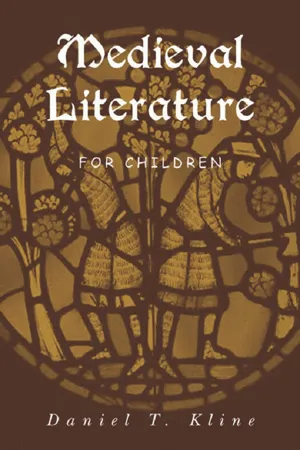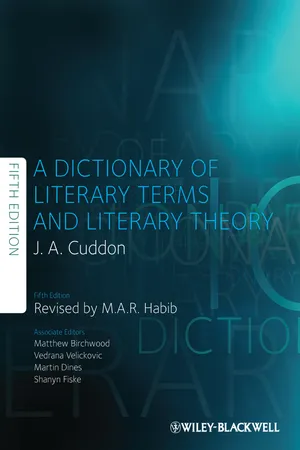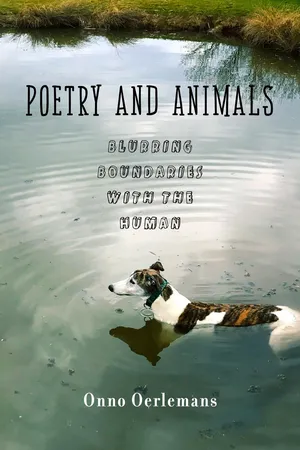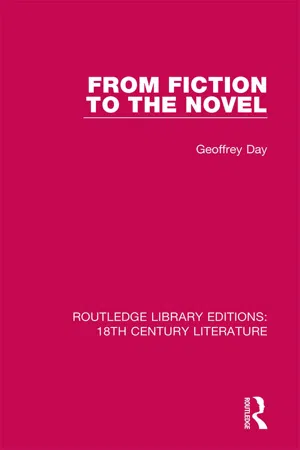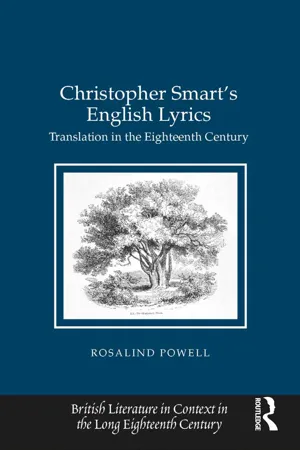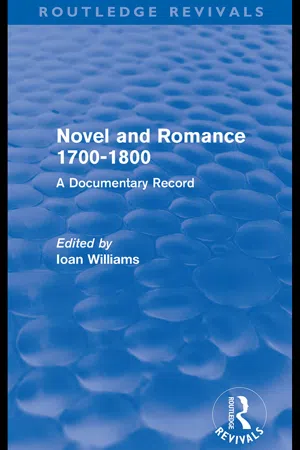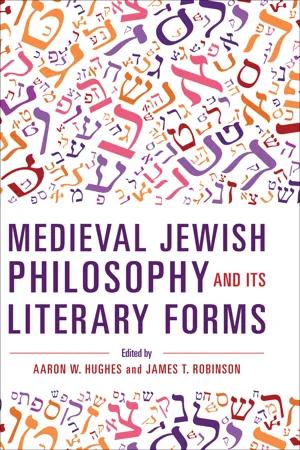Literature
Verse Fable
A verse fable is a short narrative poem that conveys a moral or lesson through the use of animals or inanimate objects as characters. It often employs allegory and anthropomorphism to illustrate human behavior and societal issues. The form has been popular throughout literary history, with notable examples including Aesop's Fables and Jean de La Fontaine's works.
Written by Perlego with AI-assistance
7 Key excerpts on "Verse Fable"
- eBook - ePub
- Daniel T. Kline, Daniel T. Kline(Authors)
- 2012(Publication Date)
- Routledge(Publisher)
Fables that serve the latter purpose, he continues, “draw the reader’s attention to certain kinds of virtue” (1.2.9). This didactic aim most often comes to mind when we think of fable as genre. As suggested by Hesiod’s hawk and the nightingale, the fable is typically a brief narrative in verse or prose that either implicitly or explicitly offers a moral or pithy message. Characters are usually animals, inanimate objects, or personifications that behave like humans, or they are human types, such as the Old Man or the Youth. Medieval fable collections, in both Latin and various vernaculars, are rooted in the Greek tradition of fable stretching back at least to the eighth century B.C. and Hesiod’s fable of the hawk and the nightingale. The better-known fabulist of early Greek culture, however, is Aesop, who as legend has it was a freed slave from Samos living in the sixth century B.C. (Blackham, 5; Handford, xiv–xv). While Aesop, if he was indeed an actual person, probably never wrote down his stories, several later Greek writers published fable collections that purported to be from him. In particular, Demetrius of Phalerum, writing in the fourth century B.C., composed a collection of fables in Greek prose that, according to H. J. Blackham, “seems to have been Aesop for the classical world” (7). With their interest in things Greek, the Romans, of course, also picked up on the fable. Horace, for instance, alludes to fables in several Satires and Epistles and, like Hesiod, incorporates a fable in a poem when he tells the tale of the country mouse and the city mouse (Satires, 2.6.77–117). In this fable, a city mouse visits a country mouse and, after seeing its poor den and eating its simple food, invites the country mouse to dine in the city. The latter accepts and is initially impressed with a sumptuous meal at a palace; soon, however, ferocious dogs chase them from the hall - J. A. Cuddon, M. A. R. Habib(Authors)
- 2012(Publication Date)
- Wiley-Blackwell(Publisher)
Ffable
(L fabula , ‘discourse, story’) A short narrative in prose or verse which points a moral. Non-human creatures or inanimate things are normally the characters. The presentation of human beings as animals is the characteristic of the literary fable and is unlike the fable that still flourishes among primitive peoples.The genre probably arose in Greece, and the first collection of fables is ascribed to Aesop (6th c. BC). His principal successors were Phaedrus and Babrius, who flourished in the 1st c. AD. Phaedrus preserved Aesop’s fables and in the 10th c. a prose adaptation of Phaedrus’s translation appeared under the title Romulus , a work whose popularity lasted until the 17th c. A famous collection of Indian fables was the Bidpai , which were probably composed originally in Sanskrit c . AD 300. Many versions of these were made in prose and verse in different languages between the 3rd c. and 16th c. The best of the medieval fabulists was Marie de France who, c . 1200, composed 102 fables in verse. After her came La Fontaine who raised the whole level of the fable and is generally acknowledged as the world’s master. He took most of the stories from Aesop and Phaedrus but translated them in his verse. His Fables choisies were published in twelve books (1668, 1678–9, 1694).La Fontaine had many imitators: principally, Eustache de Noble, Pignotti, John Gay, J. P. C. de Florian and Tomás Iriarte. Later, Lessing followed the style of Aesop. John Gay’s Fifty-One Fables in Verse were published in 1727. In Russia the greatest of the fabulists was Ivan Krylov, who translated a number of La Fontaine’s fables and between 1810 and 1820 published nine books of fables. More recently Kipling made a notable contribution to the genre with Just So Stories (1902). Mention should also be made of James Thurber’s droll Fables of Our Time (1940) and George Orwell’s remarkable political satire Animal Farm (1945), which is in fable form. See also- eBook - ePub
Poetry and Animals
Blurring the Boundaries with the Human
- Onno Oerlemans(Author)
- 2018(Publication Date)
- Columbia University Press(Publisher)
3 Similarly, in the representation of animals, animal-oriented criticism decries the various ways in which animals have been used and subjected, including the ways in which we have supplied them with cultural and social meaning. Projecting meaning diminishes our sense of their distinctness, makes them merely subjects of our power, and co-opts their presence. Thus extreme versions of anthropomorphism are offensive not just to those who wish to preserve some sense of the distinctive power of human being but also to those sympathetic to an idea of animal difference. In this chapter I want to explore poems that use animals allegorically to represent something else. My goal is to examine the category of allegorical animal poems frequently invoked as a way of distinguishing what “real” animal poetry is. Does such a category exist? How can we define the boundaries between poems that use animals to signal purely human concerns and those that represent animals in themselves? My argument is that in the early modern history of English literature, allegorical representations of animals are characterized by doubleness and complexity; rather than transparently referring to a primarily human significance, animal allegories simultaneously hide and reveal the contested nature of the boundary between human and animal.The purely anthropocentric, or allegorical, animal poem has an origin in the animal fable. This ancient form is not, strictly speaking, poetic, since animal fables are narratives, though many of these are in verse. Indeed, animal fables are surprisingly diverse, being expressed orally, in prose and verse, and having survived in various forms for millennia. Animal fables involve talking (or otherwise anthropomorphized) animals who allegorically reveal an explicit vice or virtue or some other form of folk wisdom. Fables fulfill the Longinian dictum to please and to instruct, which is perhaps why they figure so prominently in literature of the Middle Ages. It is nearly standard wisdom that fables are not actually about animals and that the allegorical purposes of these figured beings—their comic and simplistic characters, the fact that they are made to speak—make them imaginary creations solely in service of human culture. Joyce Salisbury says about animal fables that “while these texts seem to be about animals, in fact, the works use animals to discuss human society, to mirror humanity. When we study these texts, we learn very little about animals and a great deal about what medieval thinkers thought about themselves.”4 Nona Flores argues that although people of the Middle Ages no doubt were more familiar with domestic animals than we are, animals were converted into symbolic meaning through various cultural forms, including animal fables, so that there came to be an easy and obvious distinction between the actual animals and their representations. The act of representation in fables and bestiaries (a kind of field guide to animals that included descriptions of the symbolic meaning of textual animals, in addition to knowledge based on observation) explicitly converted the animals into human signifiers.5 - eBook - ePub
- Geoffrey Day(Author)
- 2020(Publication Date)
- Routledge(Publisher)
Almoran and Hamet, by Hawkesworth, are celebrated performances in this way. The former is admirable in description, and in that exquisite strain of sublime morality by which the writings of this great and good man are so eminently distinguished: – of the latter, the style is rhetorical and solemn, and the sentiments are in general good, but the plan is obscure, and so contrived as to infuse perplexing notions of the Divine Providence; a subject, which the elegant writer seems to have considered very superficially, and very confusedly. – Addison excels in this sort of fable. His vision of Mirzah, in the second volume of the Spectator, is the finest piece of the kind I have ever seen; uniting the utmost propriety of invention with a simplicity and melody of language, that melts the breast, while it charms and soothes the imagination.Modern Prose Fable (if we omit those sorts of it that have been already hinted at) may be divided into two kinds; which, for the sake of distinction, I shall call the ALLEGORICAL and the POETICAL . The Allegorical part of modern prose fable may be subdivided into two species, the Historical, and the Moral; and the Poetical part I shall also subdivide into the two sorts, the Serious, and the Comick. Thus the Prose Fable of the moderns may be distributed into four species; whereof I shall speak in their order. l.The Historical Allegory; 2. The Moral Allegory; 3. The Poetical and Serious Fable; 4. The Poetical and Comick Fable. These two last I comprehend under the general term ROMANCE .I. The FABULOUS HISTORICAL ALLEGORY exhibits real history disguised by feigned names, and embellished with fictitious adventures. This sort of fable may also be subdivided into the Serious and the Comick.1. Of the former, the best specimen I know is the Argenis; written in Latin, about the beginning of the last century, by John Barclay a Scotchman: and supposed to contain an allegorical account of the Civil Wars of France during the reign of Henry the third. I have read only part of the work: and what I read I never took the trouble to decypher, by means of the key which in some editions is subjoined to it, or to compare the fictitious adventures of Meleander and Lycogenes with the real adventures that are alluded to. I therefore am not qualified to criticise the performance: but can freely recommend it, as in some places very entertaining, as abounding in lively description, and remarkable for the most part, though not uniformly, for the elegance of the language.2. We have a Comick - eBook - ePub
Christopher Smart's English Lyrics
Translation in the Eighteenth Century
- Rosalind Powell(Author)
- 2016(Publication Date)
- Routledge(Publisher)
42 Fables can be universal in their social satire, which is why they are able to travel through different languages, cultures, and contexts. Just as the apologue form is manipulated to present the eighteenth-century conflict between ancient and modern learning, the competitive interactions between different animals provides a useful framework for comment on human relations and common lessons in the translated English text and its original. This focus on social comment may also help us to draw connections between the various narrative personae that Smart presents.In his definitive essay ‘On Fable and Romance’, published two decades after Smart’s translation, James Beattie differentiates between two kinds of fable: ‘In reading the Allegorical Prose Fable we attend not only to the fictitious events that occur in the narrative, but also to those real events that are typified by the allegory: whereas in the Poetical Prose Fable we attend only to the events that are before us.’43 Although we are dealing with verse renderings, Beattie’s distinction remains pertinent, and the question of whether specific fables might be read as allegories is an interesting one. In the case of Smart’s Fables , the analysis of allegorical application is complicated as we are assessing the translation of a Romanised work, and Phaedrus has already transposed many of the fables from their original Greek context before Smart translates them into English didactic pieces. Often, the intended context is clear: several fables are presented in the context of Aesop’s recitation (III.iv; III.xiii; III.xviii; IV.iv; &c.), and, as Henderson has conclusively demonstrated, Phaedrus invests his own fables with Roman themes. Importantly, the high degree of autobiographical reference and construction in the prologues to the fables creates an additional context, whilst also defining the critical tone of Phaedrus’s collection.As Champlin reminds us, it is not essential ‘to equate the poet with his creation, Phaedrus with “Phaedrus.”’44 - eBook - ePub
Novel and Romance 1700-1800 (Routledge Revivals)
A Documentary Record
- Ioan Williams(Author)
- 2010(Publication Date)
- Routledge(Publisher)
Spectator, is the finest piece of the kind I have ever seen; uniting the utmost propriety of invention with a simplicity and melody of language, that melts the heart, while it charms and soothes the imagination.Modern Prose Fable (if we omit those sorts of it that have been already hinted at) may be divided into two kinds; which, for the sake of distinction, I shall call the ALLEGORICAL and the POETICAL. The Allegorical part of modern prose fable may be subdivided into two species, the Historical, and the Moral; and the Poetical part I shall also subdivide into two sorts, the Serious, and the Comick . Thus the Prose Fable of the moderns may be distributed into four species; whereof I shall speak in their order. 1. The Historical Allegory; 2. The Moral Allegory; 3. The Poetical and Serious Fable; 4. The Poetical and Comick Fable. These two last I comprehend under the general term ROMANCE.I. The FABULOUS HISTORICAL ALLEGORY exhibits real history disguised by feigned names, and embellished with fictitious adventures. This sort of fable may also be subdivided into the Serious and the Comick .1. Of the former, the best specimen I know is the Argenis; written in Latin, about the beginning of the last century, by John Barclay a Scotchman: and supposed to contain an allegorical account of the Civil wars of France during the reign of Henry the third. I have read only part of the work: and what I read I never took the trouble to decypher, by means of the key which in some editions is subjoined to it, or to compare the fictitious adventures of Meleander and Lycogenes with the real adventures that are alluded to. I therefore am not qualified to criticize the performance: but can freely recommend it, as in some places very entertaining, as abounding in lively description, and remarkable for the most part, though not uniformly, for the elegance of the language.2. We have a Comick - Aaron W. Hughes, James T. Robinson, Aaron Hughes, James Robinson(Authors)
- 2019(Publication Date)
- Indiana University Press(Publisher)
10 or cosmological: one explains how ravens acquired their awkward gait, the other accounts for why the seas lack a foxlike creature.Complementing these differences are the “family resemblances” that demarcate the contours of Aesopian fable. The narratives conform to a pattern recognized by Walter Benjamin: they are meant to entertain, to be memorable, and to be practical or “useful”; their style is “chastely compact,” unconcerned with conveying information.11 The fabulists are unburdened with the task of describing the times and places of the action; they neither detail the biographical background of their characters nor do they provide explicit theoretical explanation for their characters’ behavior. Another critic has noticed that a fable’s characters tend to “act on the basis of desire” and are “thwarted in that desire because another character . . . opposes and defeats it, also by desire. Desire is thus vanquished by desire.”12 Other critics have remarked that, unlike fairy tales, fables “have no element of magic” and “no happy ending, except for the villains”;13 unlike fairy tales, fables do not allow for supernatural intervention or deus ex machina either to advance the aims of their characters or to save them from catastrophe.14 Aesopian fables simulate the writing of history; they describe the singularity of a past event. The import of their moral message is often questionable, ambiguous, or elusive.15 More allusive and provocative than dogmatic, the fables invite contemplation and stimulate thought rather than supply definitive answers. The fables tend to depict the implications of fixed identity, illustrating the futility of efforts to escape destiny. Typically, their preferred dramatis personae are nonhuman animals. Aesopian fables are therefore easily distinguished from the popular genre of exempla, in which the heroes to be emulated are not fictitious animals with questionable morality but actual or legendary human saints and scholars whose piety and righteousness are exemplary.16
Index pages curate the most relevant extracts from our library of academic textbooks. They’ve been created using an in-house natural language model (NLM), each adding context and meaning to key research topics.
Explore more topic indexes
Explore more topic indexes
1 of 6
Explore more topic indexes
1 of 4
